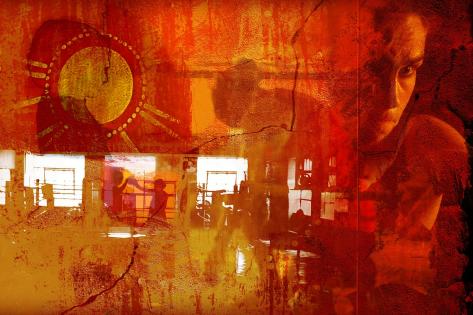Sports photographer, Jenny Evans was commissioned by the Casula Powerhouse Arts Museum to produce a series of photographs of women and sport for the Onside exhibition. She speaks here with Vi Girgis about her photographs of Eleanor Boden who trains at the Mundine Gym at the Block in Sydney.
You’re a sports photographer and you obviously hadn’t worked very much within the arts. What were your initial thoughts when you received the brief to produce works for an art exhibition?
Initially I felt like a naughty child because I could do everything that I’m not allowed to do as a press photographer. I could break all the rules, have fun. Then after I got over that excitement, I started to get really scared and asked, ‘What is art? Am I artistic?’ So I struggled with that a little bit. But mainly I was just really happy to try another way of expressing my photographic work.
What initial ideas did you have when you thought about how to approach this?
It was really good timing because I had started experimenting with Photoshop and layers, but I thought, ‘What can you ever do with that kind of work?’ When I was approached by Casula Powerhouse, my first reaction was that I could try this new way of working with images. It’s basically like a jigsaw puzzle; to take certain photos and layer them together to form one image. And it’s quite an interesting technique in the sense that you can’t take a lot of bad images and chuck them together. Everything has to be strong and an individually good photo.
It’s really interesting that you started with the technique and then went to the subject matter. How did you come to the decision to work solely with a female boxer instead of working with multiple sports women who practice different sports?
Initially I wanted to photograph six different sports women. I love boxing, so that was my first port of call. I found Eleanor and started working with her. I loved the experience and working with Eleanor so much that I couldn’t photograph anyone else. I just wanted to photograph her. Eleanor is so diverse and there are so many different parts of her life that I thought it would lend itself to being an interesting series, it wouldn’t be repetitive.
Your series is a very narrow, very concentrated exposé of the life of one sportswoman who also comes from a very different background in terms of the cultural energy of the Mundine Gym. Having made both the technical and subject matter decisions, what do you think of the results?
I’m really pleased. Mainly because I’ve had the chance to produce work that is more personal than anything I’ve done in the past. So I am pleased with the result. Eleanor is also pleased with the results, which is a major thing for me, to have the person I’m photographing be happy with the way I’ve represented them.
Now that you’ve had this experience, how do you think it’s changed your approach or understanding of photography?
It’s changed it quite dramatically as I’m taking my photography a little bit deeper. In the past, my photography was on a very superficial level. For instance, when I cover horse racing, it’s basically capturing a picture of a horse winning a race. You can’t really go that much deeper with it. But now I look out for things that I can explore a little bit more. It has changed my whole way of thinking. It has been the best work that I’ve ever done.
Similarly, how has the experience changed your understanding of sport, in particular, women in sport?
Major changes! Initially, when I questioned what it was that I love about sport, I just came up with ‘I love the biffo and the smashing of sports players together. And I love the action and capturing things within the moment, the second that it happens.’ Now I realise that sport, even though it’s a great thing to watch, has so much more to offer. It really is something that people can take pride in. Especially with the Mundine Gym, it’s great for the community. It gets people interested, brings them together and gives them something they can really be proud of. It’s an achievement which runs a little bit deeper than the biffo.
When you first walk into that gym, there is a painting that says ‘Welcome to the gym’. It’s so important, because that’s how I felt. Every single day I went to that gym, I felt welcome. There’s no judgement. It’s probably one of the safest places that I’ve been in. And that’s why I have that as my first picture [in the exhibition]. It’s a crucial part of the whole story.
Onside is on at the Casula Powerhouse Arts Museum in Sydney until 24th March.

















__small.png)










